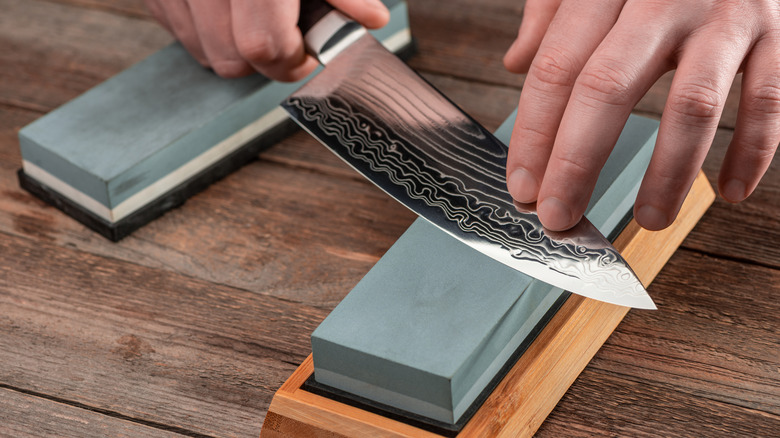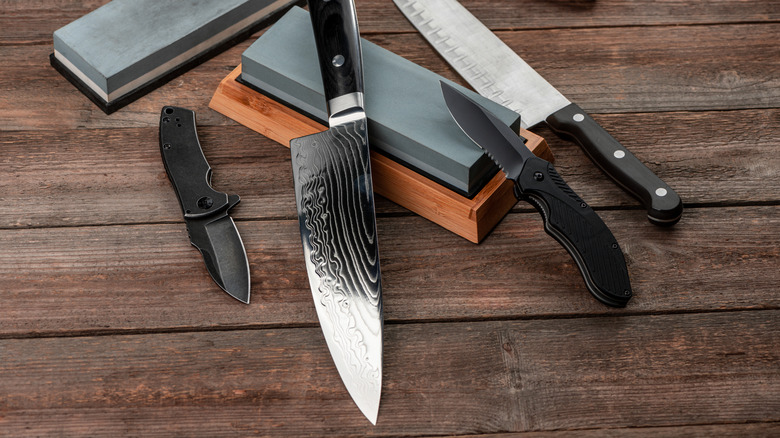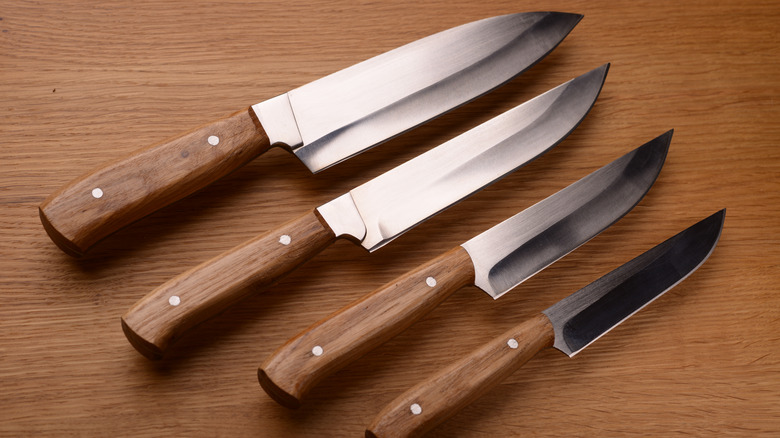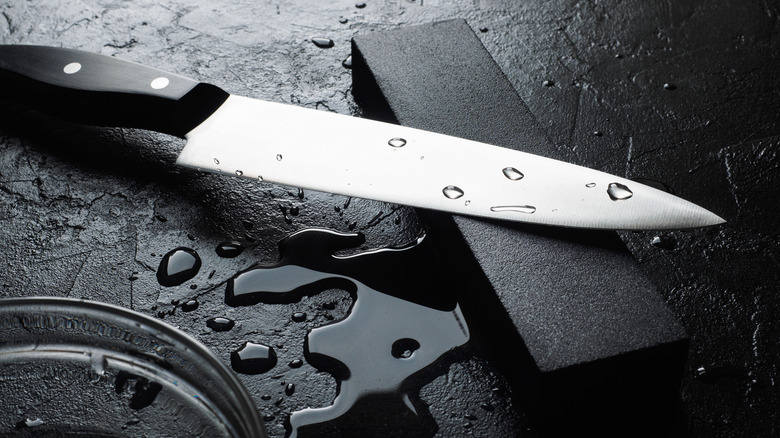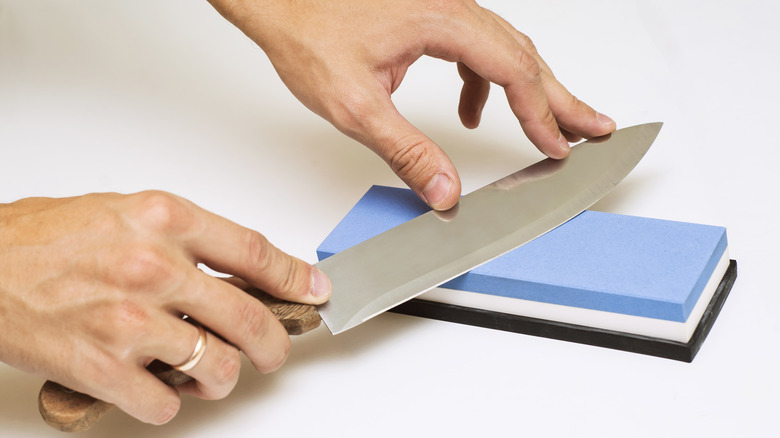What Is A Whetstone And How Do You Use It?
As any good cook knows, the single most important tool in the kitchen is your knife, or, rather, your collection of knives. As much as we love to go all out on fancy copper skillets, enameled cast iron pans, high-tech blenders, and other fun kitchen equipment, our knives — and how well we take care of them — are truly the most important factor when it comes to creating delicious meals.
It's also common knowledge that, in order to work well, a knife has to be sharp. That's why it's important to handle these sensitive utensils with care, storing them appropriately and not just tossing them into the sink like you might do with a rubber spatula or wooden spoon. But, if you're anything like us, you might neglect the single most important step in a knife's functionality, which is regular sharpening sessions. According to Howe Sharp, kitchen knives — from a paring knife all the way up a chef's knife — should be professionally sharpened once or twice a year, and at home they should be honed after every two to four uses.
What is honing, you might ask? Well, that's where a whetstone comes in. This gadget keeps your knives in tip-top shape and is a must-have tool for any home cook.
What is a whetstone?
A whetstone is an essential piece of cooking equipment that you'll want to acquire immediately if you don't have one yet. As explained by Cook's Illustrated, a whetstone is simply a stone block that acts as a sharpening tool for knives. These days, most commercial whetstones are synthetic, and typically feature two sides: one with a coarse grit, and the other with a fine grit. To appropriately sharpen a knife — more on the exact technique later — you pull the blade across the surface of the coarse side first, then use the fine side to more delicately hone the blade, says Cook's Illustrated.
The term "whet" means "to sharpen," and comes from Old English terminology. The majority of today's synthetic whetstones are, in fact, used dry. But there is also a variety of traditional whetstones made of real stone, and those are usually soaked in water or oil before use as well. There are many types of whetstones available on the market to choose from — but first, it's important to know what honing is and why you should be doing it.
Why kitchen knives have to be honed
As noted above, it's absolutely imperative that knives (even those of a home cook) remain as sharp as possible when preparing meals. As counterintuitive as it might seem, a sharp knife is actually a safer knife as well, according to Sharpening Supplies — their reasoning is, because you can cut with a sharp utensil more easily and don't need to force it, you're less likely to injure yourself. Of course, cooking is simply faster and more straightforward when you're not wrestling with a dull knife as well.
But most of us probably don't regularly hone our knives. That can be a problem, according to Misen, a maker of kitchen tools. Although it might look straight to the naked eye, at a microscopic level, the blade of a sharp knife is made up of microscopic steel teeth. When these teeth wear away, according to the brand, the knife loses its cutting power, and you'll be pressing down and tearing away at ingredients instead of slicing cleanly through them. At this point, it's important to get your knife professionally sharpened, which will re-establish those teeth. And from then on, it's imperative to hone your knife at home, which will maintain the teeth and keep them aligned.
Types of whetstones to choose from
According to Misen, whetstones for honing knives were traditionally made of actual stone. Stone quarries around the world provide the natural material for making whetstones: novaculite in Arkansas, coticule in Belgium, and a silicate-clay composite sourced in Japan, as noted by the brand. All of these traditional options are still available and do a good job at honing knives.
Depending on the type of material of a natural whetstone, it may need to be prepped before use. Japanese sharpening stones, for instance, really are "wet" stones, and must be soaked in water for anywhere from 30 minutes to more than 24 hours. Arkansas stone, on the other hand, should be spread with mineral oil before use. In both instances, the liquid fills any holes in the whetstones' surface, which ensures a more even sharpening of the knife.
But the most commonly used whetstones today are the synthetic type, and these usually can be used dry (via Cook's Illustrated), which is a whole lot simpler and easier of a process, especially when time is of the essence.
Synthetic whetstones and how to use them
Today's synthetic whetstones are usually made from silicon carbide or aluminum oxide, according to Misen. For the inexperienced knife-sharpener, these whetstones are the best option for several reasons: Number one, they're inexpensive; number two, they're readily available; and number three, their grit size is consistent, making the honing process easier.
Cook's Illustrated spells out exactly how to use a synthetic whetstone. The first good thing to know is it does not need to be soaked or prepped. To start, just place the stone, coarse side up, on a secure surface such as a rubber placemat or some damp paper towels. You'll then face the knife away from you, drawing the blade down the stone at a slight angle several times, then flipping the knife over and repeating the process on the other side of the blade. Then, you'll flip the whetstone over, repeating the process on the fine side of the whetstone until your knife is perfectly honed.
And then — voila! — you've got a super-sharp knife. Make sure to handle it with extra care and to repeat the process whenever your blade seems dull.
